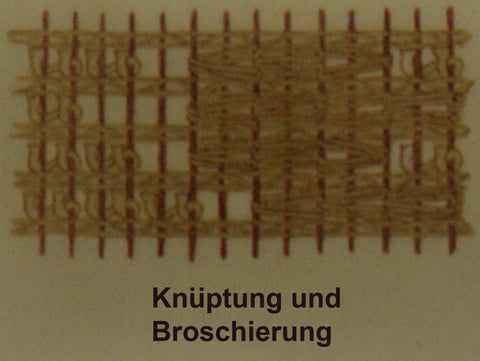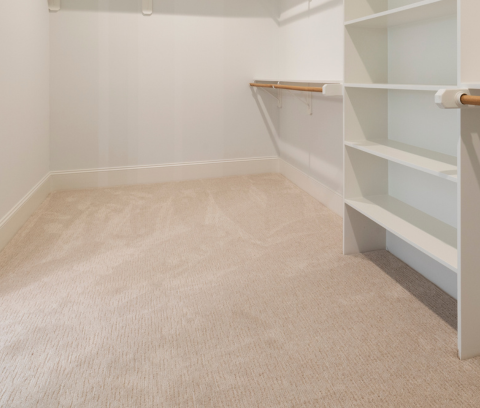Looms & Tools
Here are some of the common tools used during the process of hand-knotting a carpet:
More info here

Turkish Gordes Knotting Symmetrical
To make a Turkish knot, the yarn is passed between two adjacent warps, brought back under one, wrapped around both forming a collar, then pulled through the center so that both ends emerge between the warps.

Vertical Loom Used in Village and City Carpets
Vertical looms are undoubtedly more comfortable to operate. These are found more in city weavers and sedentary peoples because they are hard to dismantle and transport. There is no limit to the length of the carpet that can be woven on a vertical loom and there is no restriction to its width.
There are three broad groups of vertical looms, all of which can be modified in a number of ways: the fixed village loom, the Tabriz or Bunyan loom, and the roller beam loom. The fixed village loom is used mainly in Iran and consists of a fixed upper beam and a moveable lower or cloth beam which slots into two sidepieces. The correct tension is created by driving wedges into the slots. The weavers work on an adjustable plank which is raised as the work progresses.
The Tabriz loom, named after the city of Tabriz, is used in North Western Iran. The warps are continuous and pass around behind the loom. Tension is obtained with wedges. The weavers sit on a fixed seat and when a portion of the carpet has been completed, the tension is released and the carpet is pulled down and rolled around the back of the loom. This process continues until the rug is completed, when the warps are severed and the carpet is taken off the loom.
The roller beam loom is a traditional Turkish village loom, but is also found in Iran and India. It consists of two movable beams to which the warps are attached. Both beams are fitted with ratchets or similar locking devices and completed work is rolled on to the lower beam. It is possible to weave very long rugs by these means, and in some areas of Turkey rugs are woven in series.

Horizontal Loom Used in Tribal Carpets
The simplest form of loom is a horizontal; one that can be staked to the ground or supported by sidepieces on the ground. The necessary tension can be obtained through the use of wedges. This style of loom is ideal for nomadic people as it can be assembled or dismantled and is easily transportable. Rugs produced on horizontal looms are generally fairly small and the weave quality is inferior to those rugs made on a professional standing loom.

Knotting and Sewing

Kelim
Flat woven carpets are given their colour and pattern from the weft which is tightly intertwined with the warp. Rather than an actual pile, the foundation of these rugs gives them their design. The weft is woven between the warp until a new colour is needed, it is then looped back and knotted before a new colour is implemented.
The most popular of flat-weaves is called the Kilim. Kilim rugs (along with jewellery, clothing and animals) are important for the identity and wealth of nomadic tribes-people. In their traditional setting Kilims are used as floor and wall coverings, horse-saddles, storage bags, bedding and cushion covers.

Persian Senneh Knotting Asymmetrical
The Persian knot is used for finer rugs. The yarn is wrapped around only one warp, then passed behind the adjacent warp so that it divides the two ends of the yarn. The Persian knot may open on the left or the right, and rugs woven with this knot are generally more accurate and symmetrical.

Sealing of the Side Edges

Sumakh
Flat woven carpets are given their colour and pattern from the weft which is tightly intertwined with the warp. Rather than an actual pile, the foundation of these rugs gives them their design. The weft is woven between the warp until a new colour is needed, it is then looped back and knotted before a new colour is implemented.
Silk Tests
MERCERIZATION:
Cotton C6H10O5 is a polysaccharide (straight chain polymer of glucose) which comes in an alpha and beta configuration. Beta linkages have the linking OH bond on the same side as the CH2OH. Alpha linkages have the linking OH bond on the opposite side of the CH2OH.
Mercerization is a treatment of cotton thread. Immersion of cellulose in NaOH swells the cell walls and converts the cotton cells from alpha-cellulose to thermodynamically more stable beta-cellulose. The reaction is then neutralized by an acid bath. The result is to give cotton a lustrous look, increased strength and makes it easier to absorb dye (larger surface area).
It can be used to IMITATE silk.
Natural silk is a fibrous protein composed of several amino acids. It is found in the cocoons of the Mulberry silkworm. The chemical structure is prism-like and refracts light giving an iridescent look. Artificial silk is usually mercerized cotton. Viscouse Rayon (1st artificial fiber) is similar and is made by extruding dissolved pure cellulose (from cotton or wood pulp) into a chemical bath producing long filaments.
Turkish, and especially Indian and some Pakistani, carpets are often made of artificial silk (mercerized cotton). Silk carpets typically are tightly woven with more than 250 kpsi. Artificial silk is typically woven with less than about 200 kpsi. Silk carpets always have a silk fringe. Silk tests (in order of increasing reliability):
- Rub the carpet vigorously. Real silk will feel warm, fake silk will stay cool.
- Burn a small portion (i.e. fringe etc.). If the thread(s) are cellulose (cotton) the ash will be smooth and chalky and the smell will be like burned paper. The sample will continue to burn if the flame is removed and leave a glowing ember. Real silk will give a black crispy ash that powders easily and the smell of burnt hair (also a protein). The flame is invisible and it will stop burning as soon as the test flame is removed. There is little to no smoke.
- Dissolve it in a solution of 16 gr. Copper Sulfate (CuSO4) in 150 ml. water with 8-10 gr. Glycerine, or glycerol (C3H5(OH)3). Then add NaOH (lye) until the liquid is clear. This solution will dissolve a small sample of real silk (couple of min.) but leave fake silk unchanged.





















